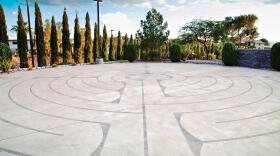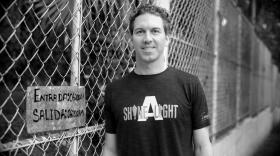Creativity central
Remembering Tamarus Street when it rocked
By Pj Perez
An occasional series in which writers extract meaning from specific locations in the valley.
Despite being anchored by UNLV, the residential side of the University District doesn’t scream “college town.” Populated primarily by blocks of low-slung, aging apartment complexes east of Maryland Parkway, the area is mostly home to lower-income and working-class households. It wasn’t much different in the mid-1990s, when I lived in several apartments along Tamarus Street. The first time, I split a roomy two-bedroom unit at Tamarus Park with my best friend, Jason, then music director at KUNV, back when “Rock Avenue” still ruled its airwaves. The second time was by myself in a sparse studio in the same complex. The third time was at Fox Hall Apartments (now “The Marq at 1600”) with my future ex-wife and her roommate, a barista at Café Espresso Roma, whose brother may or may not have wished death upon me at one point. (Long story.)
Jason and I were (and are) musicians, and our apartment became the unofficial headquarters for the Still Hour music and art collective. It was the recording and rehearsal studio for our respective bands. It was a crash pad for nomad (or just plastered) artists and poets. We were far from the only young creative types who lived in those cheap apartments, so there was always something happening somewhere in the ’hood. House parties. Collaborative art projects. Spontaneous jam sessions.
One night, my friend Rob — then the mastermind behind industrial-dance act Corinthian Flux — stopped by the Still Hour compound. Although he usually could be found behind a computer keyboard, this evening he strapped on a guitar. I plugged in a drum machine and hit Record on a nearby tape deck. Rob faux-rapped while riffing on the guitar as I laid down quasi-hip-hop beats. When Jason came home, he took over on guitar, Rob manned the drum machine, I took the mic, and as a trio we taped another 30 minutes of improvised industrial-rap-metal. This kind of stuff happened all the time.
Of course, this was within crawling distance of Maryland Parkway, whose coffeehouses, bars and record stores made the University District the de facto cultural center of Las Vegas at the time. Those cafés and watering holes are long gone, replaced by chain restaurants, karaoke rooms and liquor stores. The culturati have moved Downtown. But the memories of that time and place live on — and I still have the tape to help me remember.
Deleted Vegas scenes from Jason Bourne
The carnage-happy spy movie filmed here, but not every shot made the cut
After Bourne brutally subdues nine guys with rapid punches and kicks, a table is suddenly free at Guy Savoy.
NSA satellite spots man in long line to buy chair at IKEA: “MY GOD, IT’S JASON BOURNE!” And Bourne's all, Can't an amnesiac killing machine buy a !#%& chair?!
On East Fremont, Bourne delivers vicious throat chop to creeping gentrification.
Male stripper fights off flying shark with crotch ... wait, that's an actual scene from Sharknado 4, also set in Las Vegas.
Disgusted by prospect of tax-subsidized stadium, Bourne snaps a few necks and goes off the grid.
After rampage, Bourne enjoys DEALicious meal he saw in the copy of Desert Companion he used to kill CIA assassin.
(Jason Bourne opens July 29)
Size of place
My, what a big state you have
To give Nevadans a truer sense of how big their 110,657-square-mile state is, selfstorage.com has created maps that correct for the "Mercator effect," the distortions that occur when a round world is depicted on flat maps. (Thus our state's odd shape on some of these maps.) Compare real-size Nevada to the Koreas (1), the U.K. (2), Iceland (3) and India (4).
Funhouse mirror
Okay, we get it — Las Vegas is a weird place. It has peculiar buildings that pretend to be from other places. Its patron saints are Party-hearty Dude and Tipsy Bachelorette. So, in countless movies and books, it is the go-to setting for tales of depravity, dishonesty and despair. Martin Seay’s The Mirror Thief (Melville House, $29.95) abounds in all three, but it spreads them evenly among Las Vegas in 2003, Renaissance Venice and Beat-era Venice, California. Here to track down an aging gambler, ex-Marine Curtis Stone stays at the Venetian and surveils the simulacra-stacked Strip while the world readies for the Iraq War. It’s the perfect Vegas moment for a book about mirrors and reflections, before the advent of the theme-free CityCenter. In the Stratosphere’s lounge, a longtime resident tells Curtis: “Everything you see down there — everything! — is on its way out ... I mean, f--k Rome. This is the eternal city. Pure concept.” This would be just another crackpot Theory of Vegas, except that the book revels in impermanence, in disorienting shifts of expectations, meanings and identities. Seay’s Las Vegas is more than mere foil for gamblers and goofballs. It is a strange place, yes, but it acutely mirrors otherwise obscured desires and deceptions. Chuck Twardy












